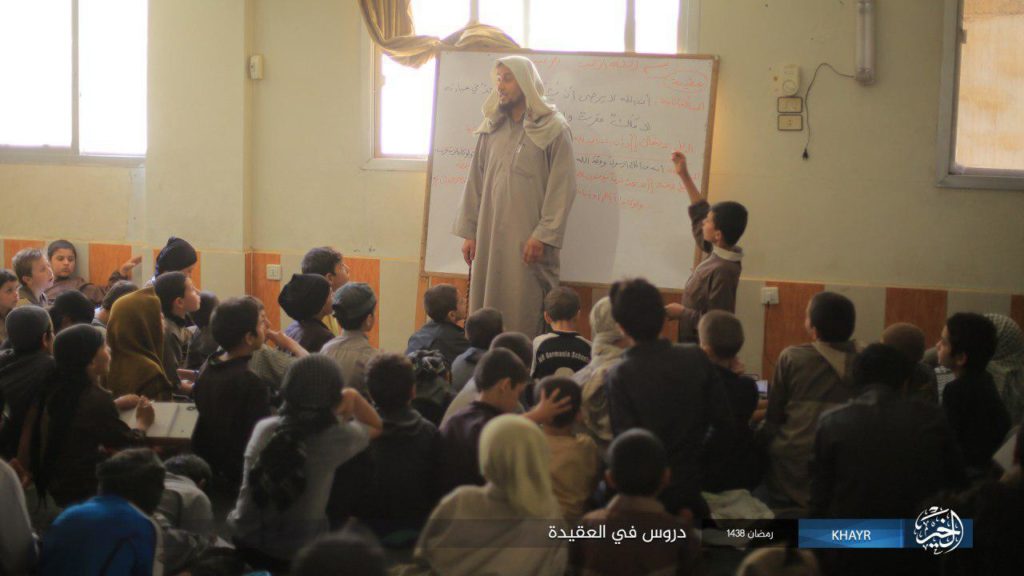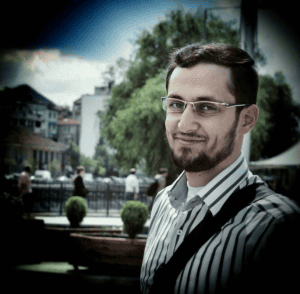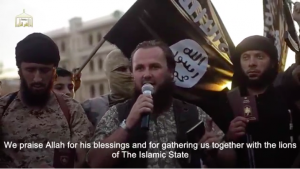
An Islamic State operative teaches a “Cubs of the Caliphate” class in Mayadin, Syria.
The US-led coalition announced today that two more senior Islamic State leaders have been killed near Mayadin, a city on the Euphrates River in eastern Syria that has become a hub for the so-called caliphate’s leadership. The US has conducted a targeted campaign against the group’s leadership in the area since earlier this year.
Both men were allegedly tied to the Islamic State’s “external” operations, meaning plots outside of Iraq and Syria. And they both perished in airstrikes on Sept. 4, according to Combined Joint Task Force – Operation Inherent Resolve (CJTF-OIR).
Abu Anas al-Shami is described as “an ISIS weapons research leader” who oversaw the organization’s “attempts to procure explosives and devised plans to use bombs for external terror attacks.”
Al-Shami was apparently an expert in concealing improvised explosive devices (IEDs), including in human corpses. In addition to implanting IEDs in dead bodies, a grim task, he supervised the jihadists’ rigging of “vehicles and buildings” with explosives. The jihadists hide their bombs in order to surprise “local forces and civilians” and “inflict terror, death and destruction,” CJTF-OIR noted.
The other newly departed Islamic State operative is Junaid ur Rehman. According to the US military, Rehman was “a senior ISIS drone pilot trainer and engineer,” who “was working to increase ISIS’s ability to weaponize drones and to conduct aerial surveillance on the battlefield and plot attacks throughout the world.”
Although the US military didn’t provide many details in its announcement, it appears that Rehman was using his extensive engineering experience to help export the group’s modified drone technology. The Islamic State has become proficient at outfitting small drones with bombs. The jihadists have frequently employed this technology on the battlefield, including during their defenses of Mosul and Raqqa. It is possible that Abu Bakr al Baghdadi’s organization is seeking to export its expertise with small drones, as well as other improvised weapons of war.
Rehman was killed south of Mayadin, in the village of al-Ashara, according to CJTF-OIR.
Mayadin is located in the Syrian province of Deir Ezzor. Bashar al Assad’s regime, backed by Iran and Russia, claims to have made significant gains in the city of Deir Ezzor in recent days. Namely, they broke the Islamic State’s siege of regime-controlled positions. The siege was first imposed in 2014, with the Assad regime and the Sunni jihadists frequently clashing in Deir Ezzor since then.
As Assad’s loyalists and allied forces press into Deir Ezzor, the US-led coalition has continued its campaign of targeted airstrikes against the Islamic State’s key leaders, many of whom are stationed a short distance from the city.
Timeline of senior Islamic State personnel killed in or near Mayadin, Syria
The US military has now identified at least fourteen Islamic State figures killed in Mayadin or the surrounding area since April of this year. In addition to Abu Anas al-Shami and Junaid ur Rehman, the US previously announced the deaths of twelve other noteworthy jihadists in the vicinity.
The deceased jihadists include one of Baghdadi’s most senior lieutenants and a key ideologue, as well as Islamic State propagandists and external operations planners. As the brief biographies for these men show, senior personnel often play more than one role in the organization.

On Apr. 6, a “close associate” of Abu Bakr al Baghdadi known as Abdurakhmon Uzbeki (seen on the right) was killed in a special operations raid near Mayadin. The US said Uzbeki “played a key role” in the group’s “external terror attack plotting” and linked him to the New Year’s massacre at the Reina nightclub in Istanbul, Turkey.
Then, on Apr. 16, the US-led coalition killed Abu Ali al-Janubi in an airstrike inside Mayadin. US Central Command (CENTCOM) described al-Janubi as a “senior media director” for the so-called caliphate.
Mustafa Gunes and Abu Asim al-Jazaeri, both of whom were allegedly part of the Islamic State’s “external operations,” were struck down near Mayadin on Apr. 27 and May 11, respectively. The US described Gunes as “a Syria-based ISIS external operations facilitator from Turkey,” who “was identified as an ISIS recruiter in the central Turkish city of Konya.” Gunes was “linked to facilitating financial support for planning attacks outside Syria and Iraq against the West.”
Al-Jazaeri, a French-Algerian, was an “ISIS external operations planner” who “was involved in training a new generation of ISIS youths, called the Cubs of the Caliphate, a high priority training program sanctioned by ISIS leadership.” In June, the Islamic State released a set of photos documenting its “Cubs of the Caliphate” program in Mayadin. (One of the photos can be seen at the top of this article.)
On May 21, a coalition airstrike near Mayadin killed Orhan Ramadani, whom CENTOM said was “actively planning external terror attacks from Syria.”

Sometime between May 25 and 27, Rayaan Meshaal, the founder of the Islamic State’s Amaq News Agency (seen on the right), met his fate near Mayadin. CENTCOM said he was killed an airstrike.
Amaq has been one of the group’s most important propaganda arms, collecting and disseminating news from jihadi hotspots around the globe. Meshaal’s media outfit packages videos, images and statements with a common branding, thereby emphasizing the idea that Abu Bakr al Baghdadi’s loyalists are fighting for the same cause everywhere from West Africa to Southeast Asia. Amaq has also played a central role in claiming responsibility for attacks carried out by Islamic State members and supporters in the West.

On May 31, the Islamic State’s “Grand Mufti,” Turki al-Bin’ali (pictured on the right), was killed in an airstrike inside Mayadin. Al-Bin’ali, who was tied to al Qaeda’s network at the beginning of his career, became an early defender of Abu Bakr al Baghdadi’s caliphate-building project. The US military described al-Bin’ali as a “close confidant” of Baghdadi’s, adding that he served as the Islamic State’s “chief cleric” and played a “central role in recruiting foreign terrorist fighters and provoking terrorist attacks around the world.”
On June 7, the US-led coalition killed two senior jihadists near Mayadin. The first was Lavdrim Muhaxheri, an ethnic Albanian from Kosovo, and “a self-proclaimed leader of ISIS foreign fighters from Kosovo.” CENTCOM explained that Muhaxheri “was known as the most prominent and radical ethnic Albanian fighter in Syria and was directly responsible for inciting jihadist ideology within European communities and encouraging foreign fighters to travel to ISIS-controlled territory.”
Muhaxheri was a prolific user of social media, but his accounts were frequently suspended. He also appeared in Islamic State propaganda, extolling the supposed virtues of Baghdadi’s caliphate.

Muhaxheri (seen on the right) was designated as a terrorist by the US State Department in Sept. 2014. Foggy Bottom noted at the time that Muhaxheri “made international headlines in July 2014 after uploading to Facebook graphic photos of himself beheading a young man.” Some of Muhaxheri’s plots abroad proved to be busts. He was “responsible for planning numerous terrorist attacks, including the failed plot to bomb the 2016 Israel-Albania soccer match in Albania,” the US military said when announcing his death.
Muhaxheri’s fellow operatives were located throughout Syria. One of his deputies, Irfan Hafiqi, perished in a June 7 airstrike near Qayira. Like Muhaxheri, Hafiqi was an “ethnic Albanian” and “involved in plotting terror attacks abroad.” The US confirmed the deaths of several other of Muhaxheri’s “senior ISIS associates,” including Jetmir Ismaili, “an ISIS external terror attack planner” who “had key connections with ISIS external terror attack planners in Europe and Syria, and personally planned and coordinated external ISIS terror attacks.” Ismaili was killed in an airstrike in Raqqa in late June.
The second jihadist killed near Mayadin on June 7 was Samir Idris, “a key ISIS financial facilitator for external terror attacks and an international money launderer.” According to CENTCOM, Idris “was trusted by senior ISIS leadership to move funds across borders to pay for external terror attacks.”
Another “ISIS external terror attack coordinator,” Razim Kastrati, was “killed along with five other ISIS fighters” in an airstrike near Mayadin on June 16. Kastrati “moved and trained foreign fighters from southeast Europe to Syria and was involved in plotting external attacks,” the US military said.
On July 13, according to CENTCOM, a jihadist known as Abu Futtum was killed along with “one associate” in an airstrike near Mayadin. Abu Futtum was “an ISIS explosives specialist” and “bomb maker.” He was also “part of ISIS’ network that instructs and incites others to take the same destructive actions, encouraging lone wolf attacks across the globe using homemade explosives.”
Then, on July 18, a jihadi money man known as Bassam al-Jayfus was struck down in Mayadin. The US military said that al-Jayfus “handled ISIS funds for terror attacks” and his death would disrupt “ISIS’s multi-national money laundering network, which is used to pay for foreign terrorist fighters as well as terror plotting and attacks throughout the world.”
Mayadin is not the only remaining hotspot for the Islamic State’s leadership. The US-led air campaign has targeted personnel in other locations along the border of Iraq and Syria in recent months, including in Al-Qaim, Abu Kamal and elsewhere in Deir Ezzor province.
But it is clear that Mayadin has emerged as one of the most important locales in the self-declared caliphate’s shrinking territory. In addition to senior personnel, the US has repeatedly targeted the Islamic State’s oil trucks and wells near the city.
Note: This article was updated since its original publication. Information regarding four additional Islamic State operatives killed in or near Mayadin was added. The names of the Islamic State figures were formatted in bold and one sentence was added to the end of the article.
For more on the airstrikes targeting the Islamic State’s senior leadership in or near Mayadin, Syria, see the reports below:
US: Abu Bakr al Baghdadi’s ‘close associate’ killed in special operations raid
CENTCOM confirms Islamic State’s ‘Grand Mufti’ killed in airstrike
Key Islamic State ‘finance emir’ killed in eastern Syria, US says
US identifies Islamic State propagandists killed in airstrikes








1 Comment
How do we know so much detail about these characters? Makes me wonder who has being paying, training and shielding them?